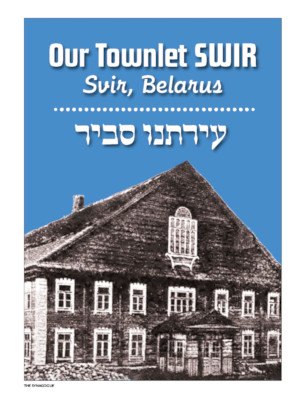

Translation of
Published by the JewishGen Press
Editor of Original Yizkor Book: Dr. Chanoch Swironi (Drutz)
Available from
for $32.00
Cover Design: Irv Osterer
Layout: Jonathan Wind
Name Indexing: Stefanie Holzman
Translation Project Coordinator: Lee Harrison z”l
Book Summary: Bruce Drake
8.5”x11” Hardcover, 210 pages with original photos
 |
Details:
Svir was a small town in northwestern Belarus, about 50 miles from Vilnius, Lithuania. Like many parts of eastern Europe, it changed hands several times as far as national borders, having been part of the Russian empire before being incorporated into the Second Polish Republic after World War I. After its occupation by the Nazis in World War II, it was retaken by Soviet Russia and emerged as part of Belarus when it declared its independence in 1990.
The book's editors saw it as a “scroll” of Svir's beginnings and aftermath: about its glory and sufferings, rise and fall, joy and grief, and the last days before its destruction at the hands of the Germans. They hoped it would tell generations to come of the vibrant life of the town during its history and help readers feel that they breathed the breath and heard the voices of those that had lived there.
Svir had a Jewish population of a little over 1,100 at the turn of the 20th century, falling to 820 in 1925. It consisted of a long street with a market-square at each end. There were mostly wooden houses, some that did not have wooden floors, and very seldom was there a house in Svir with inside plumbing. Water had to be carried from a distant well and one of the book's contributors wrote: “It is a wonder that nobody in that tiny village hated it.”
Most of the Jewish population of Svir were merchants, earning income from their shops or engaging in trade: buying up grain, potatoes, fruit, poultry, eggs, pelts, pig hair and transporting them by wagon to Vilna (as Vilnius was called then).
The beginning of the end for this small, tucked-away little town, where Jews had lived good lives for hundreds of years, came in 1941 when the Germans arrived and forced Jews into a ghetto. It was liquidated the following year with the prisoners shipped to other ghettos where many were murdered. The book chronicles the horrors of these events and concludes with a moving chapter on “Svir After Hitler's Downfall” when a small group of survivors arrived with the Red Army. Most of those who returned did not have the heart to remain living among the graves and the ruins and, as quickly as possible, left for Eretz Israel with a small number going to America.
Svir' [Rus], Świr [Pol], Śvir [Bel], Svir [Yid], Svieriai [Lith], Svyriai, Shvir
Svir, Belarus is located at 54°51' N 26°24' E and 45 miles ENE of Vilnius.
|
 JewishGen Press
JewishGen Press
 JewishGen Home Page
JewishGen Home Page
Copyright © 1999-2025 by JewishGen, Inc.
Updated 10 Jul 2024 by LA